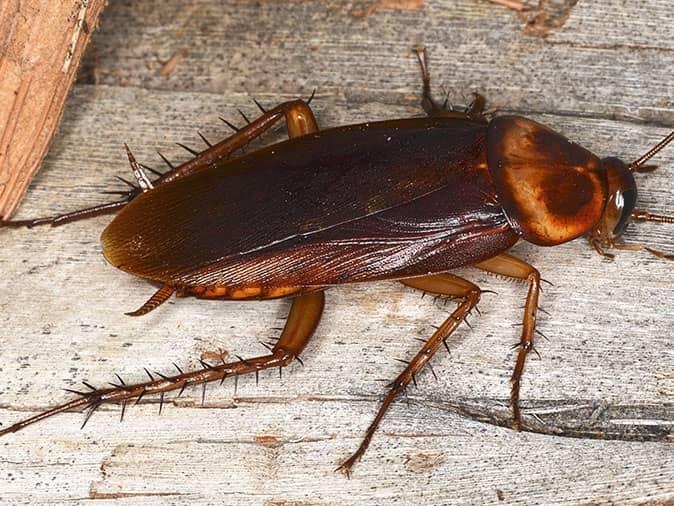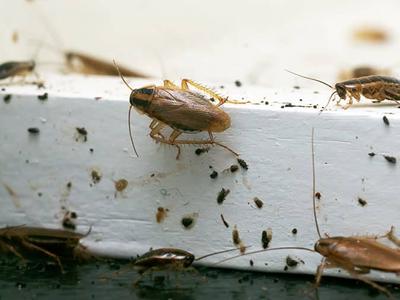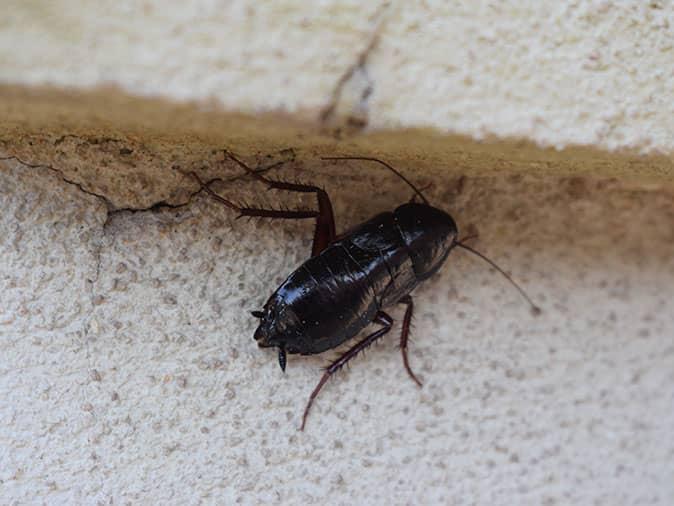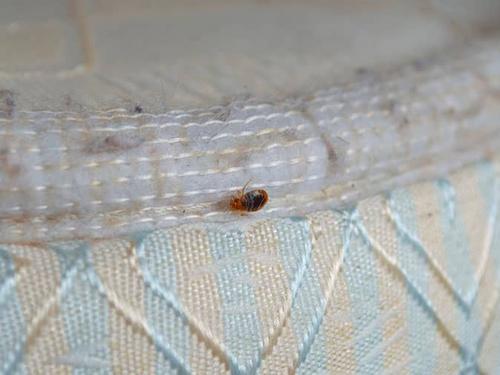Common Roach Species in Colorado
Cockroaches are one pest no one wants to see in their home or business. They’ve been around since the time of the dinosaurs and are known for being incredibly tough and hard to eliminate. While there are more than 4,500 species of cockroaches worldwide, only a few are common invaders here in Northern Colorado and the Denver metro area. The three types you will most likely find infesting local properties are listed below.

American Cockroaches
American cockroaches are reddish-brown to mahogany colored and are identified by a distinctive yellow band behind their heads.
They are the largest pest species and are capable of flight.
American roaches are most often found living in basements and bathrooms.

German Cockroaches
These cockroaches are light tan to brown in color, and although they have fully developed wings, they do not fly.
They are most often identified by the dark parallel lines that run from the back of their heads to their wings.
These house-infesting pests are often found invading kitchens and bathrooms since they prefer a moist living environment.

Oriental Cockroaches
The coloring of Oriental roaches is shiny black to dark reddish-brown. While females do not have wings, they do have large wing pads. Unlike their female counterparts, males have shortened, three-quarter-length wings.
These large roaches are unable to fly.
This species is most often found living outdoors but can be found in bathrooms, wet basements, crawl spaces, and under porches.
When are cockroaches most active?
Are Cockroaches Dangerous?
Cockroaches can bite but typically don’t. They are considered to dangerous for another reason, and that’s because they stop by sewers, dumpsters, trash cans, and garbage disposals (along with other suspect areas) before making their way into homes and businesses.
Because they pick up dangerous bacteria including Salmonella on their legs, they may introduce health hazards including vomiting, fever, and diarrhea.
Their feces and shed skins may also cause serious asthma attack in people and especially in young children and the elderly.
Why Do I Have a Cockroach Problem?
Most cockroach infestations are linked to easy access to food. Crumbs on the floor, leftovers left out, or poorly sealed pantry and trash areas make your home an inviting buffet for these pests. In multi-unit buildings, cockroaches can also migrate from an infested unit to neighboring units.
Signs You Have a Cockroach Infestation
Cockroaches are stealthy and often active at night, so many homeowners and tenants don’t realize they have an infestation until it’s already serious. Recognizing the early warning signs can help you take action before the problem spreads to your kitchen, basement, or pantry. Here’s what to look for:
Droppings
- Roach droppings look like tiny black specks, similar to ground coffee or pepper.
- You may find them in kitchens, pantries, behind appliances, or along baseboards.
- Larger species, like American cockroaches, leave droppings that are easier to spot, while smaller German roaches leave fine, scattered specks.
Egg Cases (Oothecae)
- Cockroaches lay eggs in capsule-like cases called oothecae, which can hold 10–50 eggs depending on the species.
- These cases are often tucked away in hidden areas like under sinks, behind cabinets, inside pantries, and even in basements.
- Spotting oothecae early can help prevent a full-blown infestation.
Shed Skins
- As cockroaches grow, they shed their exoskeletons.
- Finding these light-brown, translucent skins near hiding spots is a sure sign of an active population.
- Skins may accumulate in basements, behind appliances, or along crawl spaces.
Foul Odors
- A strong, musty, oily odor in kitchens, pantries, or basements can indicate a heavy infestation.
- This smell is produced by pheromones and secretions from cockroach bodies.
- If you notice it, chances are the infestation has been present for a while.
Night Activity
- Cockroaches are nocturnal and tend to hide during the day.
- Signs of night activity include roaches scurrying when lights are turned on, especially in kitchens, bathrooms, basements, and crawl spaces.
- Placing sticky traps overnight in suspected areas can help confirm their presence.
Identifying these signs early, especially in basements, pantries, and kitchens, can prevent small infestations from becoming costly, heavy infestations. Property owners who catch the problem early can take action with professional pest control, sanitation, and exclusion methods, protecting their families and property.
How Do You Get Rid of Cockroaches?
Dealing with a cockroach infestation, especially a heavy one, can be stressful for any Denver homeowner; basements, kitchens, and even pantry areas can become hotspots. The good news is that effective pest control is possible. Our Colorado pest control experts have the experience, tools, and knowledge to tackle cockroaches at every stage, from hiding spots in basements to other areas of your home.
We offer a comprehensive roach control plan for homeowners in Denver, Boulder, Colorado Springs, and across Northern Colorado.
Our residential pest solutions include professional treatment for existing roach problems plus ongoing services to ensure they don't return, allowing you to reclaim your home from these persistent pests. We also offer a pest exclusion service, Enviro Guard, to help property owners pest-proof their homes.
In addition to our residential services, EnviroPest provides commercial pest control services for facilities that battle cockroaches and other nuisance and potentially harmful insects and rodents.
Why DIY Cockroach Control Often Fails
- Hidden Roaches: Cockroaches hide in cracks, behind appliances, inside cabinets, and in basements or crawl spaces. Spraying visible roaches doesn’t reach these hiding spots.
- Eggs & Reproduction: Cockroach eggs (oothecae) are often tucked away in inaccessible areas. DIY sprays rarely kill them, meaning new roaches will hatch and continue the cycle.
- Incomplete Treatments: Store-bought baits or sprays may not provide long-lasting protection or cover the whole home or unit, allowing roaches to survive and return.
- Safety Concerns: Improper use of chemical sprays can be hazardous to children, pets, or even adults if safety instructions aren’t followed.
Is the Roach Treatment Safe?
At EnviroPest, we prioritize safety by using:
- Natural products and baits whenever possible
- EPA-registered treatments when necessary
- Minimal material application for maximum effect
Our service technicians will inform you of any specific safety measures that need to be taken.
How Soon Can You Get Here?
We take cockroach issues very seriously and are committed to helping as soon as possible. In most cases, we can respond the same or very next day.
How Much Does Cockroach Control Cost and Is There a Warranty for the Service?
The cost of service depends on the level of infestation, amount of clutter and other time consuming factors. Request a free estimate here or give us a call!
Warranty varies due to the severity and possibility of control. Your service technician will discuss this with you before service.
Preventing Cockroaches in Your Denver Home
Preventing roaches is easier than eradicating a full infestation. Key steps include:
- Sanitation: Clean spills, crumbs, and dishes promptly
- Food Storage: Seal pantry items and store food off counters
- Moisture Control: Fix leaks, run dehumidifiers, and improve ventilation
- Seal Entry Points: Close cracks in foundations, siding, windows, and doors
- Proper Waste Management: Keep trash covered and away from the house
- Outdoor Maintenance: Keep compost and garden areas at a safe distance
Regular cleaning, inspections, and professional treatments can keep your home cockroach-free year-round.

Testimonials
GETTING STARTED IS AS EASY AS 1-2-3
REQUEST QUOTE & SCHEDULE



